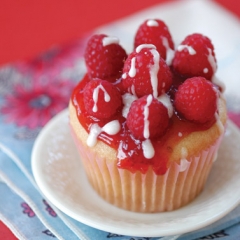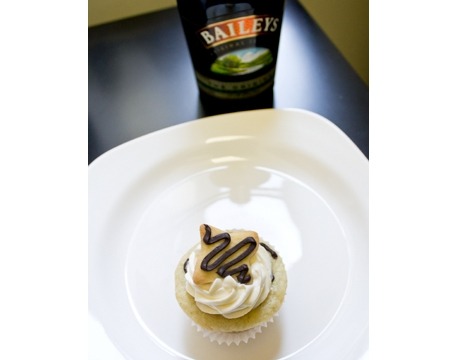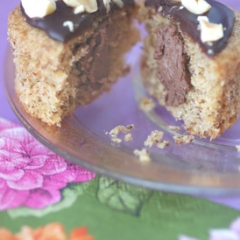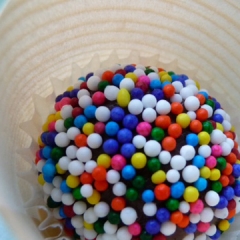Making The Perfect Cupcake
While some may argue that the cupcake trend is coming to an end, there's no doubt that it still holds a place in our hearts (and is still a dessert go-to). These mini cakes are individual treats adorned with colorful frostings, toppings, and are sometimes filled with a secret, creamy surprise. Whether you prefer vanilla or chocolate is personal, but the qualities of a good cupcake are universal.
According to Anna Beth Weber, founder of Verily Baked Goods, the perfect cupcake has manners. What she means by this is that a good cupcake presents itself well and doesn't show up with its frosting in a sloppy swirl. "It dresses appropriately for the occasion and doesn't just throw on any old wrapper. It isn't boring and dry, but fresh and interesting."
Additionally, it shouldn't leave you with a mouthful of fluff and, most importantly, it shouldn't leave you with a "bad taste in your mouth and an upset stomach from being insincerely sweet."
We sampled some of her cupcakes at the office and would have to say that they were some of the most well-mannered and well-presented cupcakes that we've ever had the pleasure of tasting. We were blown away by the lightness and moistness of each cake, and the creaminess of the frosting that didn't overload our taste buds with sugar and fat. In fact, even the anti-cupcake eaters in our office claimed that this was a cupcake they could eat over and over, again.
From using coconut milk to achieving the perfect frosting, Weber offers some guidelines and helpful tips to make you a better cupcake maker.
Avoid Dry Cupcakes
To keep her cupcakes moist and light, she uses coconut milk and hand whisks the wet and dry ingredients together until just combined. Then, she starts checking the cupcakes two minutes before the timer goes off to make sure they don't overbake.
Quality Ingredients
For Weber, the quality of the ingredients, especially the butter and chocolate, are most important. "The difference in using high-quality ingredients is infinitely more delectable."
Should You Bring All Ingredients to Room Temperature?
While it isn't always necessary to bring milk and cream to room temperature, Weber says that it's essential for butter and eggs. However, the butter shouldn't be so soft that your finger presses right through it. Weber's trick is to press her pinkie finger on top and if it sinks half an inch, then the butter is at the perfect temperature. If it's any softer, the consistency of the batter and frosting won't come out right.
Ideal Pan
Weber falls on the traditional side of bakeware and sticks to a metal cupcake pan because she feels that there is "something so classic about baking in metal pans." But silicone bakeware is also an option.
Weber is an always-line-her-cupcakes kind of baker. Her reasoning? Because cupcakes aren't as sturdy as muffins, they need to be handled more delicately. A muffin can easily be baked in a sprayed pan and popped out after being cooled, but a wrapper helps to remove the cupcakes more easily without tearing or crumbling them.
But, she wouldn't use just any old wrapper. Weber "bakes the cupcakes in a plain wrapper and then use decorative wrappers to give them pop and personality. If, instead, you bake your cupcakes in a decorative wrapper, the color and vibrancy is lost in the baking process."
Click here to see the Salted Coconut Almond Cupcakes pictured above.
Filling Up the Pan
When filling the pan, make sure not to fill it up more than two-thirds of the way because the batter will expand and overflow if filled to the rim. Weber says that it roughly comes out to a quarter-cup for most standard pans.
Ideal Baking Temperature?
The most common temperature is 350 degrees, but Weber says that will depend on the recipe. She does recommend, however, investing in an oven thermometer to check the accuracy of the oven's temperature (in case it says 350 but is really at 300). You can find ones for around $10 and they will help to improve your baking.
If You Do Make Buttercream Frosting, Read This...
Weber recommends adding the powdered sugar one spoonful at a time and to start tasting it after adding three-quarters of the recipe's amount. While she admits that this may seem painfully slow, it ensures that the sugar incorporates into the frosting without being grainy or too sweet.
While buttercream might be the go-to cupcake frosting because it's easy to whip together, Weber believes that most people don't actually like buttercream — they just endure it because it's the "black Model T Ford of cupcake frostings." In her recipes, she offers a vanilla cream that's easy to make and has a touch of sour cream, which helps give it a lighter taste. And, by adding a tablespoon of instant vanilla pudding, the texture has the stabilizing power to stay in its "coiffed shape."
Click here to see the Baileys Espresso Cream Cupcake pictured at left.
 Make Sure to Cool Your Cupcakes, or Else...
Make Sure to Cool Your Cupcakes, or Else...
If they're too hot when you decorate them, they might break apart or the frosting may melt.
Click here to see Sexy Low-Fat Vanilla Cupcakes with Fresh Berries pictured at left.
Visual Presentation Is a Big Part of Cupcakes
Presentation is a big part of the package for Weber, and it's common for home cooks to forget that aspect of enjoying desserts. But with the new accessories and techniques available, she says that it's easy for at-home bakers to make each cupcake an artistic masterpiece. Just a little effort could make the enjoyment of the recipe greater for guests.
A filled cupcake is always a delightful treat. During the summer, Weber likes to fill a fresh raspberry with the frosting, then insert it into the divot in the center of the cupcake.
Click here to see the Vegan Hazelnut Cupcakes at left.
Best Way to Store Cupcakes?
"In your stomach."
For more recipes from Weber, check out the treats below.
Twinkie Little Treats (pictured at left)




